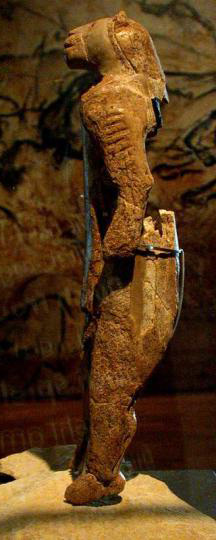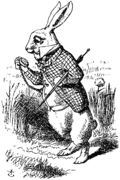Anthropomorphism

Anthropomorphism is the addition of human traits to something that is not a human. For example, the non-human might have human feelings, needs, and wants.[1] It is common for people to use anthropomorphism.[2]
Anthropomorphism is often used in stories and art. The story of the "Three Little Pigs" has a wolf and three pigs who talk and act like humans. Disney's Mickey Mouse also talks and acts like a human. Some people act and dress like anthropomorphic animals, and call themselves "furries".
The novel The Call of the Wild also uses anthropomorphism. The main character is a dog named Buck. Many other characters are dogs and wolves. In the story, the animals think and act more like humans than dogs.
In Fairy tales and mythology
For thousands of years, people have told stories and made art with anthropomorphic characters. Egyptian mythology has many gods who are part animal and part human. Roman mythology has a story about a minotaur, which is part bull and part human. The werewolf of European mythology is part wolf and part human. There is also Aesop's fables, that usually have animal characters talking in them.
Cartoons and video games
Many cartoons, shows, and movies have anthropomorphic characters. Examples include:
- Looney Tunes,
- Teenage Mutant Ninja Turtles,
- Kung Fu Panda,
- My Little Pony: Friendship Is Magic, and
- Zootopia.
Many video games also have anthropomorphic characters. A few examples:
Reasons for anthropomorphism
Humans can usually explain why humans do things. Humans are not as good at explaining why non-human things do things. This can lead to people assuming non-human things will do things like humans.
Humans learn about other humans early in life. They know more about humans than about things that are not humans, and they can remember it better.[3]
Anthropomorphism Media
From the Panchatantra: Rabbit fools Elephant by showing the reflection of the moon.
John Tenniel's depiction of this anthropomorphic rabbit was featured in the first chapter of Lewis Carroll's Alice's Adventures in Wonderland.
Big Buck Bunny is a free animated short featuring anthropomorphic characters.
Statues of the anthropomorphic turtles of Teenage Mutant Ninja Turtles
In Armello, anthropomorphic animals battle for control of the animal kingdom.
Related pages
- Furry: A section of anthropomorphism where animals and legendary creatures are shown as human-like in stories and art, It's a modern name given for Anthropomorphic Animals.
References
- ↑ Oxford English Dictionary. "Anthropomorphism, n." Oxford University Press, 1885.
- ↑ Hutson, Matthew (2012). The 7 Laws of Magical Thinking: how irrational beliefs keep us happy, healthy, and sane. New York: Hudson Street Press. pp. 165–81. ISBN 978-1-101-55832-4.
- ↑ Epley, Nicholas; Waytz, Adam; Cacioppo, John T. (2007). "On seeing human: A three-factor theory of anthropomorphism". Psychological Review. 114 (4): 864–886. CiteSeerX 10.1.1.457.4031. doi:10.1037/0033-295x.114.4.864. PMID 17907867. S2CID 6733517.





